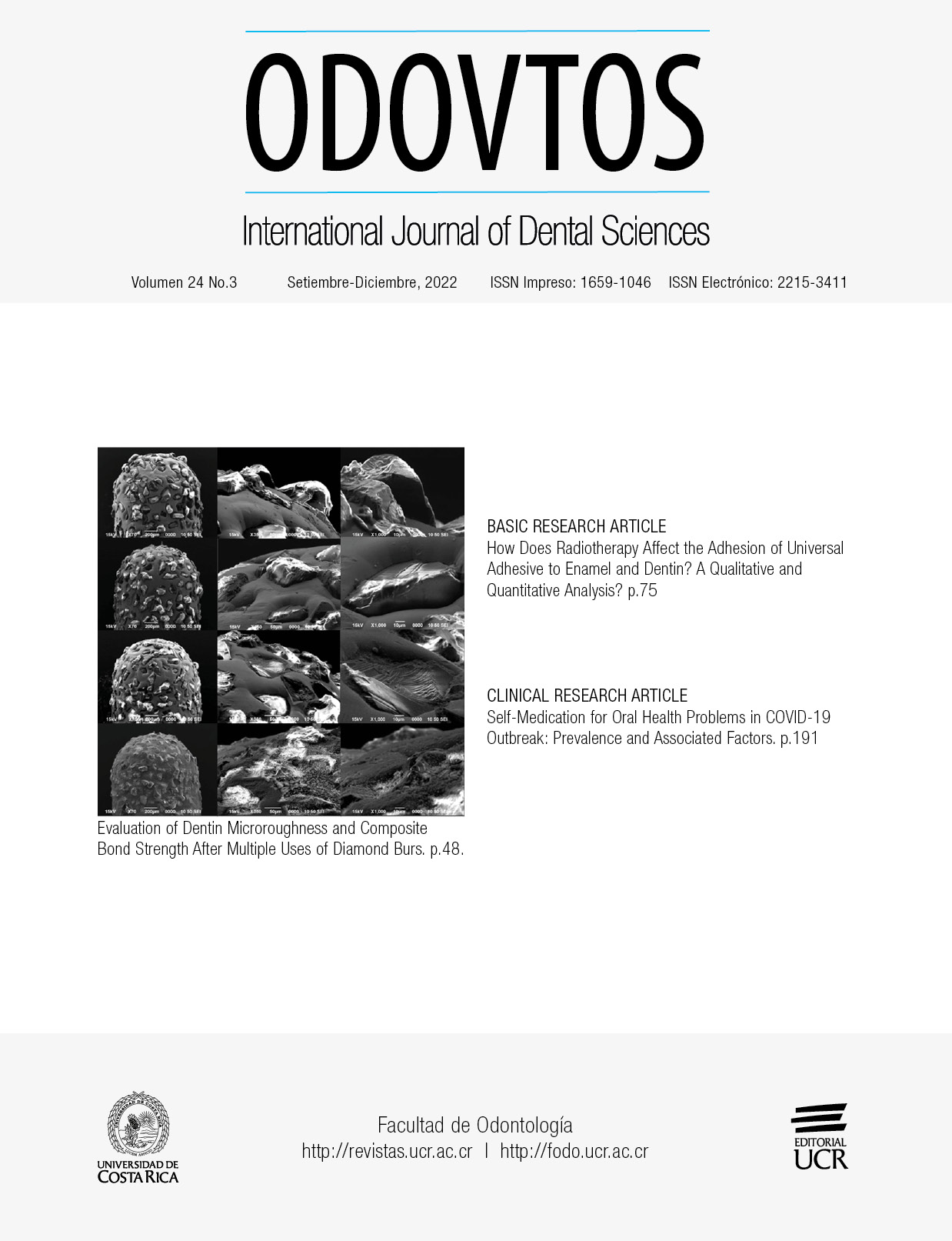Abstract
To investigate the root canal anatomy of permanent maxillary and mandibular canines in a Turkish subpopulation using cone beam computed tomography (CBCT). Retrospective CBCT data of 300 patients admitted to our clinic between 2016 and 2018 were screened and evaluated. A total of 235 patients, 100 males and 135 females, aged 14-76 years (mean age 37.27±13.40) were included in this study. A total of 191 (44,8%) maxillary canine teeth and 235 (55,2%) mandibular canine teeth were examined. The number of roots and root canal morphology according to Vertucci’s classification, the presence of accessory canals, and the position of the apical foramen of the root were analyzed. The effect of gender and age on the incidence of root canal morphology was also investigated. The majority of the teeth had a Type I canal configuration in both maxillary canines (100%) and mandibular canines (92,8%). In the mandibular canines the other canal patterns found were Type III (6,8%), and Type II (0,4%). Apical foramen was centrally positioned in the majority of the teeth, 70,2% and 66,8% in maxillary and mandibular canines, respectively. The occurrence of two roots in mandibular canines was 3,8% and the root canal separation was found 53,8% and 46,2% in the middle and cervical third of the root, respectively. No significant statistical difference was observed effect of gender and age on the incidence of the root canal morphology and the position of the apical foramen. Due to the diverse morphology and the potential presence of a second canal for canine teeth among the Turkish subpopulation, dentists should perform endodontic treatments with greater care. CBCT is an accurate tool for the morphological assessment of the root canals.
References
Patel S., Horner K. The use of cone beam computed tomography in endodontics. Int Endod J. 2009;42:755-6.
Han T., Ma Y., Yang L., Chen X., Zhang X., Wang Y. A study of the root canal morphology of mandibular anterior teeth using cone-beam computed tomography in a Chinese subpopulation. J Endod. 2014; 40: 1309-14.
Haghanifar S., Moudi E., Bijani A., Ghanbarabadi M.K. Morphologic assessment of mandibular anterior teeth root canal using CBCT. Acta Med Acad. 2017; 46: 85-93.
Abduo J., Tennant M., McGeachie J. Lateral occlusion schemes in natural and minimally restored permanent dentition: A systematic review. J Oral Rehabil. 2013; 40: 788-802.
Amardeep S.N., Raghu S., Natanasabapathy V. Root Canal Morphology of Permanent Maxillary and Mandibular Canines in Indian Population Using Cone Beam Computed Tomography. Anat Res Int. 2014;1-7.
Sharma R., Pécora J.D., Lumley P.J., Walmsley A.D. The external and internal anatomy of human mandibular canine teeth with two roots. Endod Dent Traumatol. 1998;14: 88-92.
Weng X.L., Yu S.B., Zhao S.L., Wang H.G., Mu T., Tang R.Y., Zhou X.D. Root canal morphology of permanent maxillary teeth in the han nationality in chinese guanzhong area: a new modified root canal staining technique. J Endod. 2009; 35: 651-6.
Neelakantan P., Subbarao C., Ahuja R., Subbarao C.V., Gutmann J.L. Cone-beam computed tomography study of root and canal morphology of maxillary first and second molars in an Indian population. J Endod. 2010; 36: 1622-7.
Aminsobhani M., Sadegh M., Meraji N., Razmi H., Kharazifard M.J. Evaluation of the root and canal morphology of mandibular permanent anterior teeth in an Iranian population by cone-beam computed tomography. J Dent (Tehran). 2013; 10: 358-66.
Neelakantan P., Subbarao C., Subbarao C.V. Comparative evaluation of modified canal staining and clearing technique, cone-beam computed tomography, peripheral quantitative computed tomography, spiral computed tomography, and plain and contrast medium-enhanced digital radiography in studying root canal morphology. J Endod. 2010; 36: 1547-51.
Cotton T.P., Geisler T.M., Holden D.T., Schwartz S.A., Schindler W.G. Endodontic applications of cone-beam volumetric tomography. J Endod. 2007; 33: 1121-32
Scarfe W.C., Levin M.D., Gane D., Farman A.G. Use of cone beam computed tomography in endodontics. Int J Dent. 2009; 2009: 634567.
Schwarze T., Baethge C., Stecher T., Geurtsen W. Identification of second canals in the mesiobuccal root of maxillary first and second molars using magnifying loupes or an operating microscope. Aust Endod J. 2002; 28: 57-60.
Omer O.E., Al Shalabi R.M., Jennings M., Glennon J., Claffey N.M. A comparison between clearing and radiographic techniques in the study of the root-canal anatomy of maxillary first and second molars. Int Endod J. 2004; 37: 291-6.
Pineda F., Kuttler Y. Mesiodistal and buccolingual roentgenographic investigation of 7,275 root canals. Oral Surg Oral Med Oral Pathol. 1972; 33:101-10.
Pecora J.D., Sousa Neto M.D., Saquy P.C. Internal anatomy, direction and number of roots and size of human mandibular canines. Braz Dent J. 1993;4:153-7.
Rahimi S., Milani A.S., Shahi S., Sergiz Y., Nezafati S., Lotfi M. Prevalence of two root canals in human mandibular anterior teeth in an Iranian population. Indian J Dent Res. 2013; 24: 234-6.
Vertucci F.J. Root canal anatomy of the human permanent teeth. Oral Surg Oral Med Oral Pathol. 1984; 58: 589-99.
Caliskan M.K., Pehlivan Y., Sepetcioglu F., Türkün M., Tuncer S.S. Root canal morphology of human permanent teeth in a Turkish population. J Endod. 1995; 21: 200-4.
Sert S., Bayirli G.S. Evaluation of the root canal configurations of the mandibular and maxillary permanent teeth by gender in the Turkish population. J Endod. 2004; 30: 391-8.
Altunsoy M., Ok E., Nur B.G., Aglarci O.S., Gungor E., Colak M. A cone-beam computed tomography study of the root canal morphology of anterior teeth in a Turkish population. Eur J Dent. 2014; 8: 302-6.
Kayaoglu G., Peker I., Gumusok M., Sarikir C., Kayadugun A., Ucok O. Root and canal symmetry in the mandibular anterior teeth of patients attending a dental clinic: CBCT study. Braz Oral Res. 2015; 29: 1-7.
Mağat G. A cone beam computed tomography study of the root morphology of canine teeth in a Turkish subpopulation. Selcuk Dent J. 2019; 6: 65-70.
Büyükbayram I.K., Elçin M.A., Aydemir S., Özkale C. The analysis of root canal morphologies of maxillary and mandibular canine teeth using cone beam computed tomography. Turkiye Klinikleri J Endod-Special Topics. 2015; 1: 40-6.


